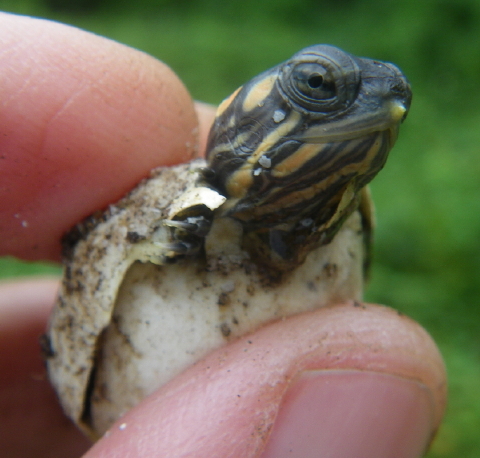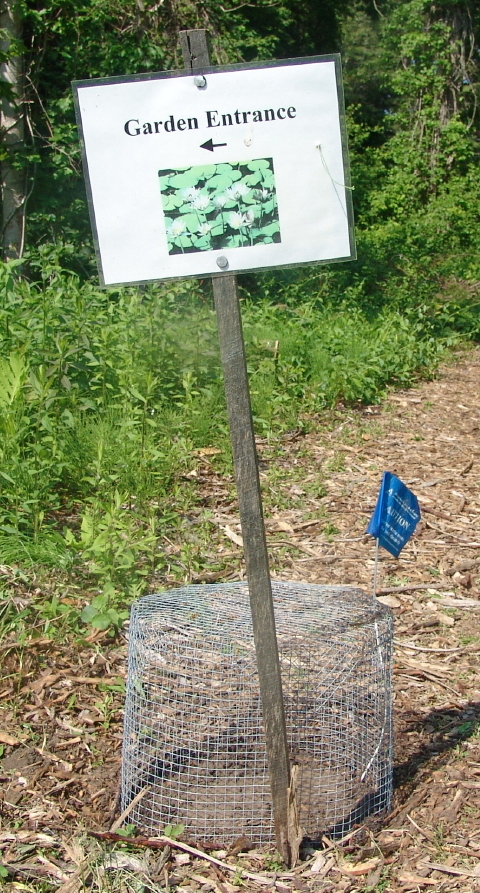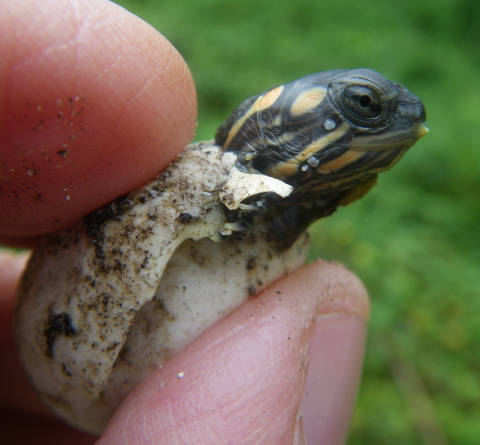Tiny Painted Turtle Hatchling Emerges
Sunday afternoon brought the first crop of 2010 baby turtles to the Wareham Community Garden off Tihonet Road. Amidst rows of stoplight red tomatoes, glistening peppers and crunchy cucumbers, between swirling vines of yellow crookneck squash and plump orange pumpkins, three painted turtle nests, each holding six eggs, incubated under the golden summer sun, growing to the rhythmic cadence of hoes, rakes and shovels, and watched over by local gardeners who seemed more concerned with their crop of baby turtles than their harvest of sugar snap peas.
Turtle Nests Protected under Predator ExcluderÂ
For the second year community gardeners witnessed painted turtles scrambling out of the Parker Mills Pond in springtime to nest in perfectly prepared vegetable plots. Natural history tells us that turtles have been laying nests in this spot for centuries, but only with the institution of these community gardens have humans stepped in to form a symbiotic partnership with their hard-shelled neighbors. The last week of May three nests were discovered, one in the act of being deposited, and all three clutches were protected by wire cages to keep them safe from hungry predators. (See Turtle Journal, Turtle “Plants Crops” in Wareham Gardens, at http://www.turtlejournal.com/?p=6278.)
Painted Hatchling Being BornÂ
After nearly 80 days of incubation, turtle experts Don Lewis and Sue Wieber Nourse decided it was time to check on Wareham’s turtle crop. They removed the cages and carefully hand-excavated the soil to examine the eggs. No tools can be as sensitive as fingertips in checking nests for fragile turtle eggs. One plump white egg lay on top of the first nest and bounced on its own when gently stroked, revealing a lively little baby still tucked inside the protective eggshell. As Lewis stroked his fingertip across the second egg, he heard the telltale rasp as though rubbing sandpaper, a sound that indicates that the egg had been “pipped” (pierced) by the hatchling’s eggtooth.
Painted Hatchling Sport Sharp Egg Tooth
Of the 18 eggs deposited by three female painted turtles, two had pipped naturally, one had succumbed to depredation by roots, one had been destroyed by insects, and fourteen more are waiting their turn to enter the world. About a third of the eggs were significantly dehydrated due to this summer’s parching heat and limited sustained rain, but they’re now being stored in clean moist soil to try to restore enough hydration to help them through hatching. The plan is to return these babies back to the Wareham Community Garden in a couple of weeks, once all the hatchlings have emerged and have become strong enough to take on the whole wild world by themselves. Human partners will have done their bit and the rest will be up to these tiny 1-inch long, 1/4 ounce powerhouses of Nature. For more than 200 million years turtles crawled and swam through the crevasses of time. With a little help from their Wareham friends, future generation of turtles will be around to teach humans how it’s done.
Click Image for Press Coverage
Cyrus Moulton of Wareham Week wrote about the turtle crop at the Wareham Community Gardens. See “A Crop of Painted Turtles.”



